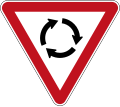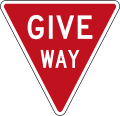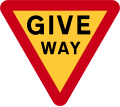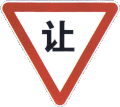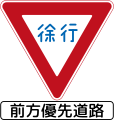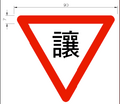Yield sign
Template:Globalize/Eng In road transport, a yield (Canada, Ireland, South Africa, South Korea and the United States) or give way (United Kingdom, other Commonwealth and English-speaking countries) traffic sign indicates that each driver must prepare to stop if necessary to let a driver on another approach proceed. A driver who stops has yielded the right of way to another. In contrast, a stop sign requires each driver to stop completely before proceeding, even if no other traffic is present. Particular regulations regarding appearance, installation, and compliance with the signs vary by jurisdiction.
History

A black triangle (within the standard down-arrow-shape of stop signs) was a symbol of "stop for all vehicles" since about 1925 in Germany. The triangular yield sign was used as early as 1938 when it was codified in Czechoslovakia in a blue-white variant without words[1] and in 1939 in the Protectorate of Bohemia and Moravia which adopted the current red-white variant.[2] In the United States, the first yield sign was installed in 1950 at First Street and Columbia Avenue Tulsa, Oklahoma, having been devised and designed (apparently independently) by Tulsa police officer Clinton Riggs.[3] [4][5] Riggs invented only the sign, not the rule, which was already in place.[6] The sign as originally conceived by Officer Riggs was shaped like a keystone; later versions bore the shape of an inverted equilateral triangle in common use today.
United States
In the Federal Highway Administration's Manual on Uniform Traffic Control Devices, a yield sign may be warranted:[7]
"...if engineering judgment indicates that one or more of the following conditions exist:
- When the ability to see all potentially conflicting traffic is sufficient to allow a road user traveling at the posted speed, the 85th-percentile speed, or the statutory speed to pass through the intersection or to stop in a reasonably safe manner.
- If controlling a merge-type movement on the entering roadway where acceleration geometry and/or sight distance is not adequate for merging traffic operation.
- The second crossroad of a divided highway, where the median width at the intersection is 9 m (30 ft) or greater. In this case, a STOP sign may be installed at the entrance to the first roadway of a divided highway, and a YIELD sign may be installed at the entrance to the second roadway.
- An intersection where a special problem exists and where engineering judgment indicates the problem to be susceptible to correction by the use of the YIELD sign."
The sign went through several changes from its original design to the sign used today. Originally invented in 1952, the sign used the "keystone" shape, before adopting the more readily recognized triangular shape. In 1969, the sign evolved into its modern version and changed from yellow to red.
-
Original design
-
Second version
-
Third version
-
Modern design as agreed to in 1969
United Kingdom
By contrast, the United Kingdom's Road Traffic Act calls for give way signs and road markings far more often at junctions (intersections) where stop signs would be used in the US. The road marking accompanying the sign consists of a large inverted triangle painted just before the place to give way.[8]
In Wales, the signs bear bilingual legends; the Welsh ildiwch appears above give way.
In the United Kingdom, a stop or give-way sign may be preceded by an inverted, blank, triangular sign with an advisory placard such as give way 100 yards.[9] In most other parts of Europe, the sign at the intersection itself is also blank.
Australia
In Australia, the Give Way sign experienced a similar evolution as its counterpart in the United States. During the 1940s and 1950s, the sign was circular and yellow. During the 1970s, the sign changed to the triangular shape and red. In the 1980s the sign adopted its modern design and gained a counterpart for use at roundabouts.
-
Original design (1940-1964)
-
Second version (1964-1974)
-
Modern design since 1974
-
Modern design for use at roundabouts
New Zealand
In New Zealand, the original design also used the keystone shape as in the United States, but used a black background with a red border. In the 1990s, the modern design was adopted.
-
Original design (1975-1991)
-
Modern design since 1991
-
Modern design for use at roundabouts since 2005
Republic of Ireland
In the Republic of Ireland, the sign reads yield in most areas, though in Gaeltacht (Irish language-speaking) areas, it reads géill slí ("Give Way") instead. Signs erected before 1997 and still in service read yield right of way. Use of the sign is similar to that of the UK.
-
Original design (1962-1997)
-
Modern design in English (1997-present)
-
Modern design in Gaeilge
Brazil
In Brazil, the "Yield" sign has the same shape and colors of the American sign, but with nothing written within. Brazilians call it as "Dê a preferência" ("Give the preference").
Thailand
Thailand uses a sign of the same shape and colors, containing the Thai phrase "give way."
Gallery
-
International standard
-
Botswana, Lesotho, Namibia, South Africa, Swaziland (blue background phased out in favour of white in all countries by 2013)
Signs with text in English
-
New Zealand, Samoa
-
Nigeria
-
Tonga
Signs with text in Spanish
Signs with text in other languages
References
- ^ Government ordinance No. 100/1938 Sb. n. a z., Czechoslovakia
- ^ Government orinance No. č. 242/1939 Sb. (Protectorate of Bohemia and Moravia)
- ^ Curtis, Gene (February 6, 2007), TPD Blog: Tulsa cop invented the 'yield' sign, retrieved 2009-04-05
- ^ Curtis, Gene (6 February 2007), "Tulsa cop invented the 'yield' sign: ONLY IN OKLAHOMA.", Tulsa World, Tulsa, OK, retrieved 2009-04-05
- ^ Fales, Edward D, Jr (September 9, 1956), "NewspaperARCHIVE.com - Search old newspaper articles online", Oakland Tribune, retrieved 2009-04-05
{{citation}}: CS1 maint: multiple names: authors list (link) - ^ "A Brief History of Yield Signs". Road Traffic Signs. Retrieved 2012-06-26.
- ^ FHWA - MUTCD - 2003 Edition Revision 1 Chapter 2B
- ^ Road Markings, www.direct.gov.uk, p. 3, retrieved 2009-04-04
- ^ Warning signs, www.direct.gov.uk, p. 1, retrieved 2009-04-04











